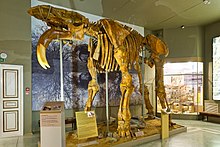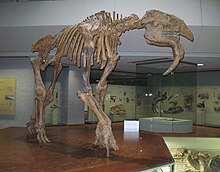Deinotherium
| Deinotherium Temporal range:
| |
|---|---|

| |
| D. giganteum skeleton cast from the Azov Museum of History, Archaeology and Paleontology
| |
| Scientific classification | |
| Domain: | Eukaryota |
| Kingdom: | Animalia |
| Phylum: | Chordata |
| Class: | Mammalia |
| Order: | Proboscidea |
| Family: | †Deinotheriidae |
| Subfamily: | † Deinotheriinae
|
| Genus: | †Deinotherium Kaup, 1829 |
| Type species | |
| †Deinotherium giganteum Kaup, 1829
| |
| Species | |
Deinotherium is an extinct genus of large,
History and naming
Deinotherium has a long history, possibly dating back as early as the 17th century when a French surgeon named Matsorier found the bones of large animals in an area known as the "field of giants" near
The genus Deinotherium was coined in 1829 by
The name Deinotherium is derived from the Ancient Greek δεινός, deinos meaning "terrible" and θηρίον, therion meaning "beast"). Some authors have on occasion referred to Deinotherium as Dinotherium, following latinization of the first element of the name. Although pronunciation remains unchanged, Deinotherium remains the valid spelling as it was coined first.[4]
Description

Deinotherium was a large-bodied proboscidean displaying continued growth between species.[
The permanent

These tusks are without doubt the most immediately visible feature of Deinotherium. Unlike in modern proboscideans, which possess tusks that grow from the upper
Although the presence of an elephant-like proboscis or trunk in Deinotherium is evident thanks to the size and shape of the external nares, the exact shape and size of this trunk is a matter that has long been debated. Historic depictions commonly portray it as very elephantine with a long trunk and tusks breaking through the skin below an elephantine lower lip. In the early 2000s Markov and colleagues published papers on the facial soft tissue of Deinotherium contesting these ideas, instead suggesting an alternative soft tissue reconstruction. In the first of these publications the authors argue that, due to the origin of these animal's tusks, the lower lip should be situated beneath them as they evolved their classic downturned appearance. They further suggest that, while a trunk would be present, it would likely not resemble that of modern elephants and instead be more robust and muscular, which they reason is evidenced by the lack of a proper insertion surface.[3][10] Although later research concurs that the trunk or proboscis of Deinotherium was likely notably different from those of modern proboscideans, the idea of a short tapir-like trunk is questioned. In particular, it is pointed out that the tall stature and still relatively short neck of Deinotherium would render it very difficult for the animal to drink without assuming a more complex posture. Thus it is suggested that the trunk must have been at least long enough for the animal to effectively drink.[11]
Species

Throughout the long history of deinotheriid research, 31 species have been described and assigned to the family, many on the basis of poorly sampled material, especially teeth of varying size.[4] The amount of species recognized by authors differs depending on researchers, but the three species most commonly considered valid are listed below.
- D. bozasi
- Known from East Africa,mastication.[10]
- D. giganteum
- The type species D. giganteum was found in Europe from the Middle Miocene to Early Pliocene. However, the exact extinction of D. giganteum in Europe is unknown. The last known occurrences in Central and Western Europe appear to be in MN13 (Messinian to Zanclean), while material from Russia might extend the range of the species to MN15 (Ruscinian). Fossils of D. giganteum have also been found on the island of Crete in the upper Miocene Faneroméni Formation, during a time when the island was still connected to the mainland.[14]
- D. indicum[15]
- The Asian species, D. indicum is distinguished by a more robust dentition as well as p4-m3 intravalley tubercles and found across the Indian subcontinent (India and Pakistan) during the Middle and Late Miocene. It disappeared from the fossil record about 7 million years ago (Late Miocene). Although it is generally regarded as valid, some researchers argue that it is synonymous with D. proavum and that the later name would take precedence. Pickford, for instance, argues that fossils from Iran create a geographic link between European populations and the Indian specimens, concluding that they may be one single wide ranging species.[13]
One hypothesis opposing this three-species model suggests that, rather than being a single consistent species lasting throughout the Miocene, D. giganteum actually represents multiple chronospecies, with the type species only applying to the intermediate form.
Other species that have been described include:
- D. levius (Jourdan, 1861)
- D. levius is a European species of Deinotherium recovered from sediments dating to the late Astaracian to Aragonian. While it is considered a synonym of D. giganteum by some researchers, others propose that it is a stratigraphically distinct chronospecies and the earliest of European Deinotherium. In accordance to this hypothesis, D. levius would eventually give rise to D. giganteum by the Vallesian stage of the Miocene,[16] after which the two species continued to coexist until the formers extinction.[7]
- D. proavum (Eichwald, 1831)[17]
- D. proavum is a large bodied species of Deinotherium that may be a junior synonym of Deinotherium giganteum. Other research meanwhile proposes that it, alongside D. giganteum and D. levius, is part of a single anagenetic lineage of Deinotherium species. For this hypothesis it has been suggested that it evolved from D. giganteum during the late Vallesion to Turolian, with early members of the species still being similar in size to its ancestor before surpassing it later during its range. However, the assignment of specimens to D. proavum is largely based on stratigraphy and size, making the differentiation between species difficult, especially with some research suggesting that the two species continued to coexist.
Skull of D. giganteum - D. gigantissimus[18]
- D. gigantissimus from Romania is typically considered to be a larger specimen belonging either to D. giganteum[15] or D. proavum[7] (depending on how many species are recognized by the respective author). The situation is similar in D. thraceiensis[1] from Bulgaria, another notably large deinothere, described in 2006 but usually lumped into other European species by subsequent publications.[7] The state of Asian species is especially complex, with a multitude of specimens being described from poor remains. These include D. sindiense (Lydekker, 1880), D. orlovii (Sahni and Tripathi, 1957), D. naricum (Pilgrim, 1908), and D. anguistidens (Koch 1845), all of which are generally considered dubious by publications of the 21st century.[15][16][19] Only one other species from Africa was described, D. hopwoodi (Osborn, 1936), based on teeth from the Omo Basin in Ethiopia. However his research was published posthumously and was predated by D. bozasi, described two years prior.[12]
Another matter that complicates the amount of Deinotherium species recognized by science is the state of the genus Prodeinotherium. One prevailing theory is that Prodeinotherium is a distinct genus ancestral to the larger Deinotherium species. Other researchers, however, argue that the anatomical differences, the difference in size in particular, are not enough to properly distinguish the two, which would subsequently render species of Prodeinotherium as Deinotherium instead. This would create the combinations D. bavaricum, D. cuvieri (both European), D. hobleyi (Africa), P. pentapotamiae, and possibly D. sinense (Asia).[20][19][2]
Deinotherium was a widespread genus, found across vast areas of East Africa, Europe, the
Evolution

The origin of Deinotheres can be found in the Oligocene of Africa with the relatively small bodied
| |||||||||||||||||||||||||||||||
Paleoecology

Several key adaptations suggest that Deinotherium was a folivorous, browsing proboscidean that preferred open woodland habitats and fed on the leaves of the tree canopy. In Asia D. indicum has been associated with wet and warm, low-energy woodland[21] and in Portugal deinotheriid remains were found in regions corresponding with moist, tropical to subtropical woodland conditions likened to modern Senegal.[2] A browsing lifestyle is supported by the inclination of the occiput that gives Deinotherium a slightly more raised head posture, and their teeth, which strongly resemble those of modern tapirs, animals that predominantly feed on fruits, flowers, bark and leaves. Their limbs show some notable differences to Prodeinotherium, allowing for a more agile mode of locomotion and allowing for easier travel across open landscapes in the search of food, which coincides with the widespread breakup of forests and expansion of grasslands during the time Deinotherium lived in Europe. Fossil finds from the Austrian Gratkorn locality [22] and the Mainz Basin in Germany indicate that Deinotherium was not a permanent resident in some areas it inhabited. In Austria it has been suggested that they traversed areas on a regular basis, while in Germany there is evidence for the animals range shifting with changing climatic conditions, present during subtropical climate conditions and absent in subboreal conditions.[13]
One of the most enigmatic features of Deinotherium are their downturned tusks and their function. Research conducted on Deinotherium suggests that these tusks were likely not used for digging, nor are they sexually dimorphic, leaving use in feeding as their most likely function. These tusks exhibit patterns of wear, in particular on their medial and caudal sides. In a 2001 paper Markov and colleagues argue that Deinotherium could have used its tusks to remove branches that would have gotten in the way of feeding, while using the proboscis to transport leaf material into its mouth. From there Deinotherium would have used a powerful tongue (inferred based on a notable trough at the front of the symphysis) to further manipulate its food. Different tusk anatomy in young individuals would suggest altered feeding strategies in juveniles.[3]
References
- ^ S2CID 255676762.
- ^ a b c d Antunes, M.T.; Ginsburg, L. (2003). "The Deinotherium (Proboscidea, Mammalia): an abnormal tusk from Lisbon, the Miocene record in Portugal and the first appearance datum. Evidence from Lisbon, Portugal" (PDF). Ciencias da Terra. 15: 173–190.
- ^ a b c Markov, G. N.; Spassov, N.; Simeonovski, C. (2001). "A reconstruction of the facial morphology and feeding behaviour of the deinotheres". The World of Elephants. Proceedings of the 1st International Congress: 652–655.
- ^ a b c Huttunen, K. (2002). "Systematics and Taxonomy of the European Deinotheriidae (Proboscidea, Mammalia)" (PDF). Annalen des Naturhistorischen Museums zu Wien. 103: 237–250.
- .
- S2CID 206536505.
- ^ S2CID 221141900.
- S2CID 55095894.
- S2CID 86014255.
- ^ a b Markov, G.N.; Spassov, N.; Simeonovski, C. (2002). "Reconstruction of the facial morphology of Deinotherium gigantissimum Stefanescu, 1892 based on the material from Ezerovo, South Bulgaria" (PDF). Historia Naturalis Bulgarica. 14: 141–144.
- ^ Göhlich, U.B. (2010). "Tertiäre Urelefanten aus Deutschland". Elefantenreich – Eine Fossilwelt in Europa. pp. 340–372.
- ^ .
- ^ S2CID 129506763.
- doi:10.4267/2042/311.
- ^ S2CID 213316461.
- ^ S2CID 222215203.
- .
- ^ a b Vergiev, S.; Markov, G. N. (2010). "A mandible of Deinotherium (Mammalia: Proboscidea) from Aksakovo near Varna, Northeast Bulgaria". Paleodiversity. 3: 241–247.
- ^ .
- ^ a b Zhan-Xiang, Qiu; Ban-Yue, Wang; Hong, Li; Tao, Deng; Yan, Sun (2007). "First discovery of deinothere in China". Vertebrata PalAsiatica. 45 (4): 261–277.
- ^ a b Sankhyan, A. R.; Sharma, S. L. (2014). "In situ dental remains of Deinotherium from Northwest Indian Siwaliks". Himalayan Geology. 35 (1): 75–81.
- ^ S2CID 55030720.
- ISBN 978-1-4899-2513-8.
Further reading
- Carroll, R.L. (1988), Vertebrate Paleontology and Evolution, WH Freeman & Co.
- Colbert, E. H.(1969), Evolution of the Vertebrates, John Wiley & Sons Inc (2nd ed.)
- Harris, J.M. (1976) Evolution of feeding mechanisms in the family Deinotheriidae (Mammalia: Proboscidea). Zool. J. Linn. Soc. 56: 331-362





